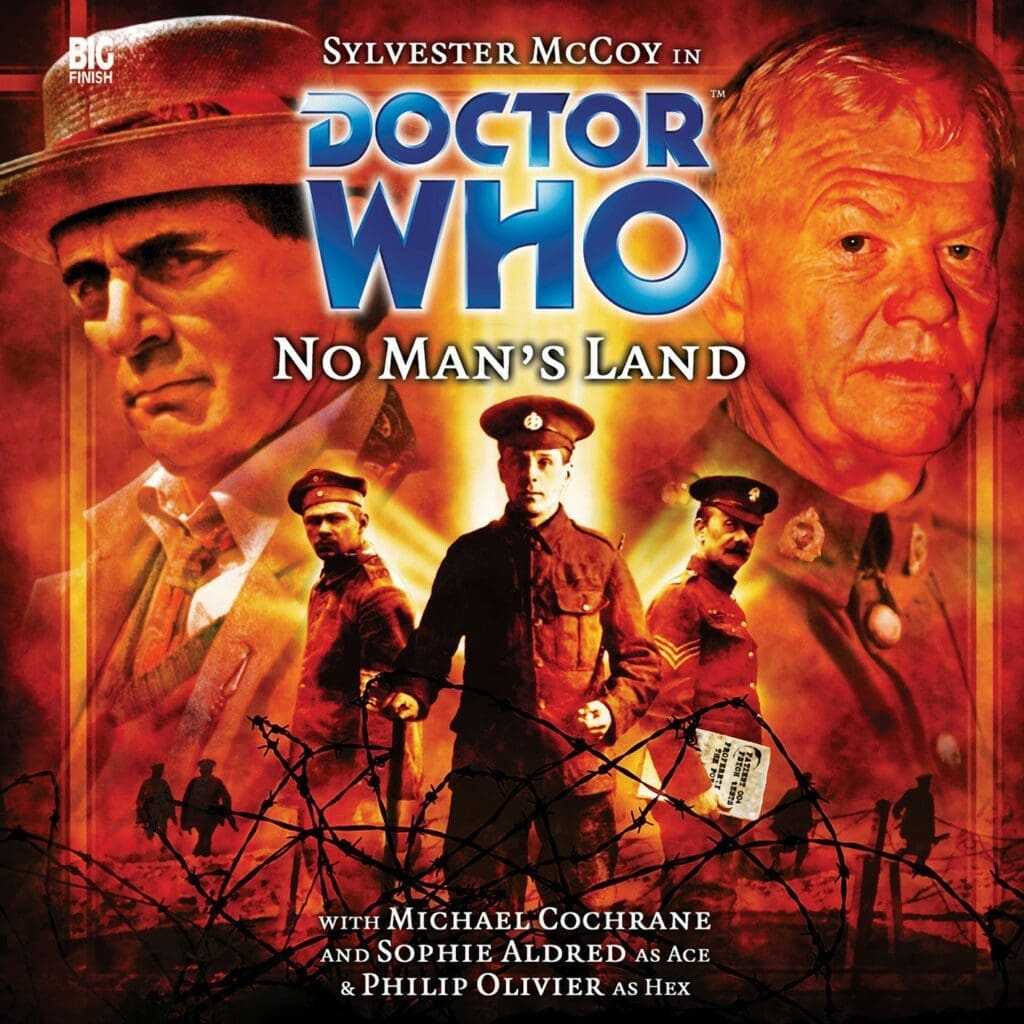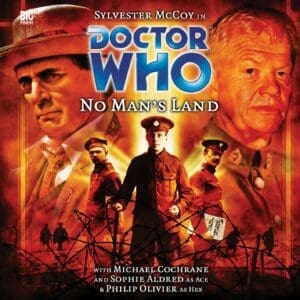
Main Range • Episode 89
No Man’s Land
Reviews and links from the Community
This review contains spoilers
Review of No Man’s Land by deltaandthebannermen
No Man’s Land is the Doctor Who story which is relatively unique in its setting – a pure historical set during the Great War. There are stories with Weeping Angels and Daleks infiltrating this time period but setting the Doctor and his companions down in the middle of this terrible conflict and just allowed them to experience it as was is far more unusual.
Admittedly, No Man’s Land does still have the slightest of sci-fi twists but overall, the Doctor, Ace and Hex have to fight against the horrors of humanity. There were many parts of this where I could see it working as a Young Indiana Jones story, particularly their investigations around the hospital and when Ace and Hex head out to an abandoned church in No Man’s Land.
From the outset, things seem a little awry at the military hospital. A letter has been received announcing the arrival of the Doctor and two associates. This gives the TARDIS crew an immediate in road and a compulsion to investigate the mystery not only of the letter, but also of the murder it predicts.
Even without the letter, things don’t seem right. The soldiers are regularly subjected to the ‘Hate Room’ where they are more or less brainwashed into becoming killing machines. What’s bizarre is that nobody seems to be questioning this rehabilitation tactic, not even the Doctor initially – and that’s with Hex being subjected to the room. If there’s one criticism I’d level at the story it’s that obviously odd or suspicious occurrences go almost without comment. Hex, for example, goes missing for quite a while (he’s being held captive in the Hate Room’ and yet the Doctor and Ace don’t seem to be actively searching for him. The hospital can’t be so big that they couldn’t do a quick sweep to find out where he’s got to.
When the Doctor does eventually find Hex, very little is made of the fact that he has been subjected to the process or why Sergeant Wood put him there.
Aside from this, though, the story rattles along at a good pace with the focus, initially, being on the predicted murder, and then shifting to the machinations of Lieutenant Colonel Brook and what’s really going on at the hospital.
There’s also some interesting examination of the role of soldiers and the idea of cowardice. I remember, many, many years ago, watching a schools serial called ‘How We Used to Live’ based around the First World War. One aspect which has stuck with me all these years was a character being sent a white feather as a sign of cowardice for not enlisting in the armed forces. It’s a horrible example of society guilting people into put themselves up for death and yet here, in No Man’s Land, we see how soldiers were constantly battling not just the enemy, but prejudice in their own ranks either for perceived cowardice or unentitled privilege.
Listening to No Man’s Land has highlighted something which has been bugging me about Sophie Aldred. I recently listened to the ‘Hector trilogy’ (Nucleus of the Swarm, Mask of Tragedy and Signs and Wonders). Weird creative decisions about Hex/Hector’s character development aside, one frustrating aspect of those audios is Sophie Aldred’s sudden change of performance style for Ace. In stories like No Man’s Land, it’s clear Ace has matured and Aldred’s acting is spot on. In the Hector trilogy, though, Aldred has become very shouty, Ace seems to have regressed into a teenager again and, strangest of all, she sounds more and more like a boy. Aldred, a few years ago, did a series for CBeebies called Tree Fu Tom. In that, she provided the voice for the main character – a boy called Tom who shrinks down and hangs out with fairy folk. What seems, oddly, to be happening is that Ace is turning into Tree Fu Tom. More and more, her voice acting seems closer and closer to that performance than it does to those from No Man’s Land (and Gods and Monsters, although there are hints of Tree Fu Tom breaking through, even there).
Listening to No Man’s Land highlighted the change in Aldred’s performance to me and it’s frustrating that directors of the audios don’t seem to be noticing this weird shift in her performance. Aldred can be amazing as Ace, particularly in the run of stories from The Harvest through to Gods and Monsters, but it’s just not working after that (and I haven’t heard great things about her performance in the more recent audios teaming her up with Mel again – all of which are supposed to occur after her travels with Hex).
No Man’s Land is also a good vehicle for Philip Olivier’s Hex, a companion I’ve had trouble with in previous audios for this marathon. Here, he is great, and bounces well off Ace and the Doctor. Sylvester McCoy also gives a good turn as the Doctor without too much of the ‘angry’ acting and more of the ‘quiet menace’ that he’s much better at.
The guest cast are good, although due to it all being male a few of the soldiers are a little difficult to distinguish at certain points of the story. Leading them, as Brook, is Black Orchid and Ghost Light alumni Michaael Cochrane, who is brilliant as a man able to charm and intimidate in equal measure, turning on a sixpence as the situation demands it.
Historically, this story hits many of the same beats as previous WW1 set stories, but with specific focus on the hospital and No Man’s Land itself. The overall mystery does have a slightly sci-fi reveal (in that the people Brook works for are hinted as being the Forge, which – signficantly – ties in to Hex’s tragic family background). But this reveal is a minor tag at the end of the story, almost an afterthought, and the main thrust retains its historical focus.
No Man’s Land is a bit of a forgotten gem and a Big Finish audio worth seeking out as a good example of Doctor Who doing ‘history’ and of the 7th/Ace/Hex TARDIS team.
This review contains spoilers
Review of No Man’s Land by PalindromeRose
Doctor Who – The Monthly Adventures
#089. No Man’s Land ~ 10/10
◆ An Introduction
It genuinely surprises me how little focus the First World War seems to get in fiction. Speaking as someone who spent a lot of their childhood staying up far too late playing first-person shooters, the games industry has only very recently stepped further back in time to showcase the conflict with Kaiser Wilhelm II.
There had never been a conflict quite like the Great War, with many soldiers suffering from what was once known as Shell Shock, and hoping to be injured enough to go back home. But things are a lot more sinister at Charnage Hospital, as the TARDIS team are about to find out…
◆ Publisher’s Summary
It is 1917 and the Doctor, Hex and Ace find themselves in a military hospital in northern France. But the terrifying, relentless brutality of the Great War that wages only a few miles away is the least of their concerns.
The travellers become metaphysical detectives when the Doctor receives orders to investigate a murder. A murder that has yet to be committed...
Who will be the victim? Who will be the murderer? What is the real purpose of the Hate Room? Can the Doctor solve the mystery before the simmering hate and anger at Charnage hospital erupts into a frenzy of violence?
◆ The Seventh Doctor
This is the last review I’m writing for this TARDIS team for quite a while, and what a way to end my Seventh Doctor marathon. ‘No Man’s Land’ sees Sylvester McCoy slipping into investigative territory, as he grills the other characters on the murder yet to happen. It’s a marvellous performance.
The Doctor doesn’t appear to have a pulse, because of some sort of emergency shutdown system Time Lords have. He tells Private Taylor that a soldier without a moral compass to guide him is one of the most frightening things in the world. He’s faced more firing squads than Brook has had lukewarm dinners. The Doctor found a letter in Brook’s office that confirmed his worst suspicions… that the Forge was behind everything that happened at Charnage Hospital!
◆ Ace
‘No Man’s Land’ is yet another opportunity for Sophie Aldred to deliver a brilliant performance, despite getting the least amount to do out of our three protagonists.
Ace isn’t sure if it was a shell or a mine that got them, but she didn’t hang around to check… she was to busy flying through the air! She did First World War poetry at school; Wilfred Owen and Siegfried Sassoon.
◆ Hex
Following on from his masterful performance in ‘The Settling’, Philip Olivier continues to flourish as a performer. He gets some of the strongest material in ‘No Man’s Land’ and really does it justice.
Hex didn’t just do the poetry at school, he learnt the facts of World War One; four years, eight million people killed. It’s clear that the atrocities he saw at Drogheda are still weighing heavily on his mind. There are guys younger than him out there in the trenches, thousands of them will never get home. He couldn’t do what they’re doing. Hex isn’t on anyone’s side, which merits him being called a coward by Sergeant Wood… who proceeds to leave him in the Hate Room overnight! He has no idea what happened to his mother, because his dad never talked about it (he’s gonna have quite the shock come ‘Project: Destiny’).
◆ Story Recap
After nearly being blown to kingdom come by artillery fire, the TARDIS team regain consciousness inside a military hospital in northern France, where they receive orders to investigate a murder that hasn’t happened yet. Unfortunately, this is the least of their worries.
Charnage Hospital is filled with battle-scared troops, suffering from both physical and mental afflictions, but someone is attempting to turn them into the ultimate killers. The Hate Room is specially designed to heighten the soldiers emotional response, to make them single-minded and obsessed with eliminating the Boche.
The Doctor’s day is about to get a whole lot worse though, when he discovers who the true masterminds of this immoral experiment are.
◆ The Daily Hate
‘No Man’s Land’ appears to have a really mixed reputation amongst the fandom, which genuinely shocked me. I understand that slow-burning adventures aren’t for everyone, but anyone who has read my reviews will know that they hold a special place in my heart.
This whole story revolves around an event carried out at the hospital known as “the Daily Hate” - the Lieutenant-Colonel likes to remind the troops of who the enemy are to keep them focused, listening to recordings of racist propaganda whilst they are forced to fire blank rounds at dummies dressed up like German soldiers. The idea being that he can turn them into killers fuelled on nothing but hatred; a battalion of well-trained berserker troops to clear out the enemy. It’s brainwashing in a nut-shell.
Hex claims that the soldiers who have went through the Hate Room end up no better than the Cybermen, but I think that it would be more accurate to compare them to Daleks – all emotions suppressed or eradicated, all barn pure hatred! It’s a really interesting idea, and Martin Day executes it really well.
◆ Unhinged Experiments
This entire operation is being supervised by the hospital’s commanding officer, and he is a brilliant bad guy. Lieutenant-Colonel Brook is an incredibly driven soldier and clearly quite patriotic. He’s incredibly manipulative too, taking full advantage of the death of Private Taylor’s friend to rile him up, to make him even more angry at what the Germans are doing to their side in the war.
Towards the end of the story, Brook even admits that he’s making it up as he goes along; testing the psyches of his soldiers to see which ones crack under pressure and which hold up. Ladies and gentlemen, what a total head-case!
It is worth mentioning that Brook’s entire operation at this military field hospital was set up by the Forge. Hardcore BigFinish fans will be aware that Hex is in fact the son of Cassie Schofield. She was a friend to the Sixth Doctor and Evelyn, who sadly got infected with the Twilight virus whilst working at the Dusk Casino. Before she could be cured, she was shot dead by the Forge’s enigmatic leader; Nimrod. The choice to have the Forge be responsible for the events of this story makes it feel like we’re on the edge of a story arc. Pretty soon, Hex is going to find out the truth of what happened to his mother… and how the Doctor was there to witness it!
◆ Sound Design
A field hospital only a few miles away from the front lines, where psychological experiments are being carried out by a member of the Forge. Simon Robinson does an astoundingly good job with the sound design for this release, with the Hate Room being a particular highlight.
We open the adventure with soldiers chanting “Die! Die! Die!” as they take part in the Morning Hate, before opening fire on the dummy soldiers. Crackling music from the turn of the century plays on Brook’s phonograph. We get a proper glimpse of the Hate Room when it’s being shown to Captain Dudgeon; soldiers all angrily declaring how they’ll kill the Bosch, whilst a recording of Hindenburg plays in the background. Private Taylor clicks away at his military grade typewriter, writing a letter to his girl back home. Buzzing electrodes, as Hex is subjected to torture inside the Hate Room. Rain pours down, as Ace and Hex squelch through the muddy wastes of no man’s land. A biplane flies over no man’s land, whilst soldiers take pot shots at both it and the Doctor’s companions. A shattering window, as the Doctor and Private Taylor leap out of Brook’s first floor office. The rumbling engine of a Triumph motorbike, as the Doctor and Taylor flee Charnage Hospital.
◆ Music
Simon Robinson is also handling the score for ‘No Man’s Land’, which is wildly different to any of his previous compositions. Harsh and industrial, this really shouldn’t work as well as it does.
I’m reminded of ‘The Haunting of Thomas Brewster’, another adventure with an incredibly odd score that actually works really well.
◆ Conclusion
“Each German death brings us one step closer to finishing this business off!”
‘No Man’s Land’ is going to be my last Seventh Doctor review for a while, because I’ve been marathoning his adventures for over a month now and don’t want to get burnt out, but what a tremendous story to end my marathon on.
The idea of mental conditioning has already been explored in my absolute favourite Seventh Doctor story, ‘Red’ by Stewart Sheargold, but this adventure offers a really fun take on the topic. You literally have the main villain subjecting injured soldiers to recordings of British civilians being murdered whilst German officials chant orders, all to increase their hatred for the enemy and turn them into single-minded homicidal nut-cases.
Speaking of our main villain, Michael Cochrane is absolutely the highlight of ‘No Man’s Land’. Lieutenant-Colonel Brook can seem quite sane and patriotic one moment, and become a ranting and raving lunatic the next… but he has you hanging on his every word.
I’d also like to do something I rarely-if-ever do in these reviews, and draw your attention to the covert artwork for this story. This burnt orange image is absolutely gorgeous, and McCoy looks royally miffed too.
‘No Man’s Land’ certainly seems a lot more divisive than I first thought it would be, but I highly recommend giving it a listen.
Community Ratings
(Updates coming soon:)
Add the last X members who rated it here
Add number of Favs, and who they are, here







